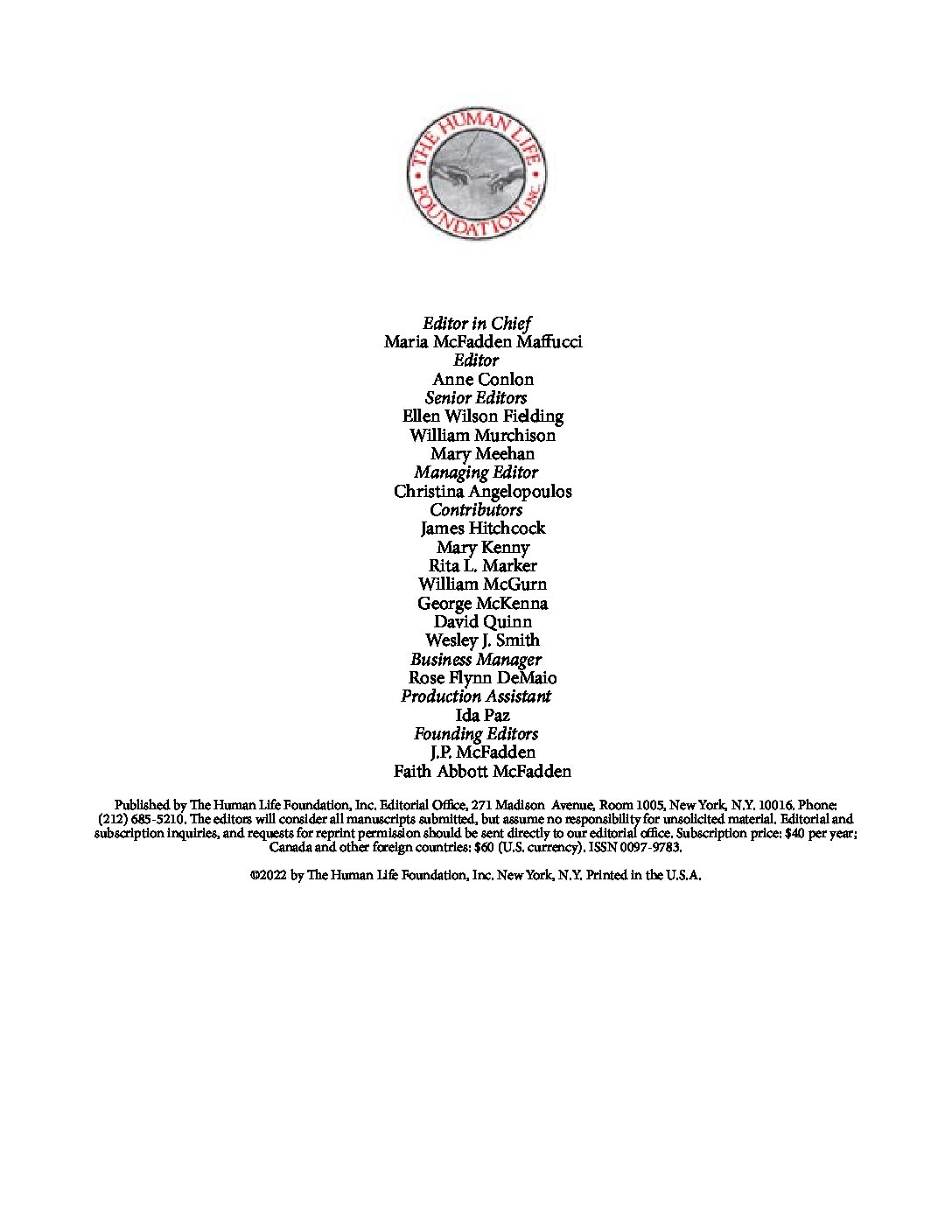
-
About this issue…
. . . Senior editor William Murchison, in our lead article, asks: “Could a post-Roe world be on the way?” The answer will be imminently clearer by the time this quarterly is in your hands—the Supreme Court’s decision in Dobbs v. Jackson is due by the end of June. Will Roe be overturned, or significantly crippled? Meanwhile, this issue of the Review is an at-times wrenching testament to so much of what Roe has wrought over the past half-century—over 60 million abortions in the United States, with countless other lives forever damaged. And yet, you will also find here hope amidst the suffering. Georgette Forney, of the Silent No More Awareness Campaign, for example, speaks of the trauma of abortion, and the shame; yet she and the ministry she founded shine light into the darkness, offering healing and new life. The paradox of suffering and grace is also evident in Brian Caulfield’s moving profile of a pro-life warrior, Chris Slattery, now fighting for his own life, with courage and gratitude for opportunities he has been given.
The road to Roe was paved by the advent of the birth control pill, and, as our new contributor Grace Emily Stark writes, what it “overpromised and undelivered.” 60 years on, it is clear that what was touted as liberating for women has often had the opposite effect. The availability of the Pill enabled institutions—business, academia, medical research—to ignore challenges unique to women and focus on areas where women can “be like men.” Abortion as a “solution” to failed birth control soon followed, and now abortion is, incredibly, “shouted” as an integral and positive right for women. On page 91, (Appendix C), we have a stunning illustration of what such a “right” really is. Rosemarie Tischer Stith’s sculpture, “Triumph,” depicts a woman with her fist raised in victory, yet, as her husband Richard Stith describes in his column, at what cost— “under her feet lies her vanquished baby.” Thanks go to Richard Stith for permission to reprint his column; to The American Mind for permission for Seth Barron’s “The Cult of Abortion” (Appendix D), and to The American Conservative for permission to reprint John Hirschauer’s “She Buried Their Bodies” (Appendix E). Thanks as always to the cartoon genius of Nick Downes.
Keep an eye out for an upcoming book by contributor Alexandra DeSanctis, co-written with Ryan Anderson: Tearing Us Apart: How Abortion Harms Everything and Solves Nothing, due out in early summer from Regnery. Finally, I have a correction from our previous issue: In my review of The Family Roe: An American Story, we misspelled author Joshua Prager’s last name. Apologies to Mr. Prager! And congratulations on a book that Peggy Noonan (in the Wall Street Journal) called “stupendous, a masterwork of reporting . . . If you want to understand Roe more deeply before the coming decision, read it.”
Maria McFadden Maffucci
Editor in Chief
-
Will a conservatively configured Supreme Court finally put a brake on “top-down enactments like Roe” that attempt to “cram great moral determinations down people’s throats”? That fateful decision, writes senior editor William Murchison, by “shielding pro-choice advocates from the need to give an account of their moral thinking,” paved the way for today’s widespread “culture of assertion,” in which those with differing viewpoints seek to overpower their opponents rather than persuade them. “Is it possible,” Murchison wonders in “Life after Dobbs,” that “somewhere down the line, though probably not without more shouting and roughness . . . we might recover somewhat our lost gift for moral discourse?” We will surely need it should the Court send the abortion question back to state legislatures, where there is already much shouting and roughness.
In “An Enduring Legacy: Ronald Reagan’s Pro-life Influence on America,” Chuck Donovan, who worked in the White House Correspondence Office during the Reagan years, reminds us that “unlike those who argue that abortion is a matter to be decided by the states,” the 40th president believed unborn children had “existing legal protection under the 14th Amendment.” (Might a Supreme Court justice or two agree?) While he directed his administration to implement pro-life policies, notes Donovan, Reagan himself used his command of the written word to sow the pro-life message: in scores of letters to private citizens, in national proclamations, and in the “unprecedented presidential essay” he wrote for this journal in 1983. (We reprint the ever-relevant “Abortion and the Conscience of the Nation” in Appendix A.)
Read Full Intro
